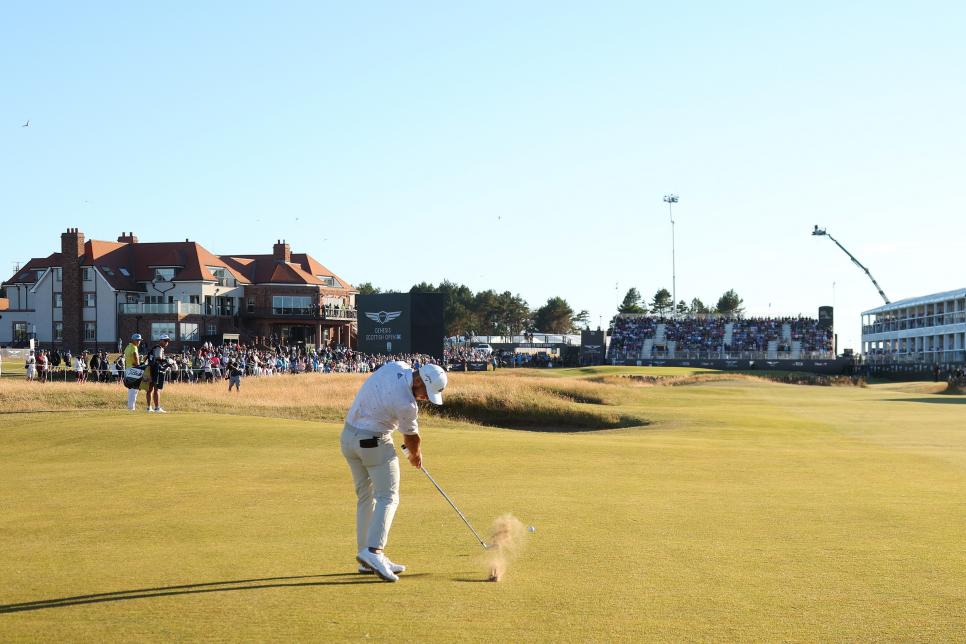For all the discussion of where golf’s going and who’s behind the wheel, there’s no question the DP World Tour’s been relegated to the back seat. The circuit’s fate was a bargaining chip in professional golf’s schism; Saudi Arabia viewed it as an avenue into the sport’s ecosystem, the PGA Tour deemed its European counterpart as a means to keep an emerging threat at bay. The DP World Tour product itself, however, was an afterthought, and actions (and inactions) by both the PGA Tour and LIV Golf manifested the long-held fears of the Old World cognoscenti: the league had become a second-class citizen.
So as the professional game transitions into an era of detente, it’s time to make good on the once-promised strategic alliance between the European and American entities in an effort that will support the former and strengthen the latter. It’s time for the PGA Tour to sanction a month-long European Swing.
There’s no need to squint to see how this could come to fruition, for the framework is already in place on the front end. Historically the Irish Open and Scottish Open have preceded the Open Championship, although this year the Irish will be played in the northern autumn. Under our proposal, the Irish would return to its historical date before the Scottish, which is in its second year as a co-sanctioned event by the PGA and DP World Tour. When played at the proper venues the Irish and Scottish serve as a two-week Open Championship primer to both players and fans. “Proper” is the operative word, however, and a word that does not always apply to either tournament.
Issues with sponsorship, fields, the DP World Tour schedule, infrastructure and attendance have kept the Irish and Scottish Opens from consistently visiting the best links courses each country has to offer, instead defaulting to hosts that are seeking exposure or relevance. It’s not that courses like Galgorm Castle, Mount Juliet, Loch Lomond, Gleneagles and the K Club are bad; conversely, in lands in which golfers routinely make pilgrimages to these places are far from holy sites. Many of the above courses are also of the parkland variety, a miss considering what is indigenous to the region – and what makes Scotland and Ireland so venerated – is links golf. In an exceedingly paint-by-numbers game, links golf requests (maybe the best phrase is “requires”) a player to draw outside the lines. Precision and power take a backseat to vision, artistry and feel. Links golf asks innumerable questions of a player’s talent, mind and heart, which is why it is often considered the ultimate test in the sport. Parkland golf, even when it’s good, is never that.

Similar sentiments apply to the Renaissance Club. It’s a fine setup and has been an adequate host to the Scottish for the past five years. It’s also new, opening in 2008. Compare that with some of its neighbours, which have been around for 200 years and are dripping in history. The Renaissance is a man-made marvel, whereas most Scottish links were erected by the meeting of land and sky and sea and sculpted by the hands of time. That the Renaissance is one of the more expensive tee times in Scotland, a country where golf is affordable and a game of the common man, goes against the very spirit of the national championship.
In short, where the Irish and Scottish have been played – and how they’ve been played – well, it’s sort of like visiting Rome and grabbing lunch at Panda Express.
It’s not that those who run the Scottish and Irish Opens are ambivalent to their plights. There are constraints, prerequisites and realities that come with hosting a modern professional tournament. An urban centre has to be in the vicinity to lodge visitors and facilitate travel; both Scotland and Ireland boast few metropolitan areas. The course itself needs to be able to challenge the world’s best players, and the host club’s physical footprint must provide for tens of thousands of guests, stands, concessions and corporate tents. Most Scottish and Irish links tend to be smaller in scale and their coastal topography, while scenic, is not always conducive to accommodating crowds. The links are also shorter in length, problematic in a professional game that continues to be dominated by distance.
Above all else, there is the necessity of monetary backing. It’s no secret that the European Tour has been in dire financial straits for some time, a predicament only worsened by the onset of the COVID-19 pandemic. It’s how the Dubai-based DP World company was able to purchase naming rights for the European Tour Group in 2021, and why the European Tour listened to overtures from Premier Golf League and Saudi investors before the PGA Tour offered support. The struggles extend to tournament purses, forcing most of Europe’s top talent to migrate to the United States to compete for bigger paydays. As a corollary sponsors are less likely to subsidise a tournament that lacks marquee attractions. It’s a vicious self-fulfilling cycle and one of the many reasons why PGA Tour officials dubbed the European Tour Group as “an underinvested and borderline distressed asset”, according to PGA Tour documents that were accidentally made public earlier this month.
That’s why the PGA Tour’s involvement in a potential European Swing is so crucial. With the tour sanctioning the Scottish Open the event’s strength-of-field average doubled, most notably with more frontline firepower in 14 of the world’s top 15 players teeing it up. The tour’s collaboration brought in Genesis as a sponsor, and Genesis increased the purse 28.5 percent from the previous year and a whopping 177 percent since 2016. A similar knighting of the Irish Open – which had a $US6 million purse last year, lower than every PGA Tour full-field event – could produce dividends in the same ballpark, especially since the Irish has historically labored with tournament sponsorship. With the PGA Tour serving as a benefactor in both players and dollars, the Irish can return to its normal spot on the schedule (it was moved to the fall in hopes of garnering a better field) and be freed from resorts like the K Club and Mount Juliet to explore more suitable playing venues. Lahinch, Ballyliffin and Portmarnock are past Irish Open hosts that fans would like to see back in the rotation, as is Royal County Down – arguably the best links in the world that has hosted four Irish Opens.
Regarding the Scottish, the tournament should be more ambitious now that it has the tour’s patronage. This is not to say every potential fantasy could come true; Royal Dornoch, consistently ranked as the best links in Scotland, is too remote to host an event, as is Machrihanish. And charming spots like Nairn, Crail and Elie likely won’t be formidable enough against 150-something professionals. However, the tour’s backing should remove some barriers. DP World Tour officials had originally scouted Cruden Bay as a potential Scottish host, although ultimately tournament officials wanted a site closer to Edinburgh. Yet Cruden Bay is just 30 minutes from Aberdeen, a town that is equipped to handle the trappings of a tour event, and Cruden Bay itself is a quirky masterpiece that the world deserves to see. Many pros visit North Berwick’s West Links during Scottish Open week on their own accord, and though the links may be somewhat on the easier side for the world’s best it’s so full of character and romanticism that fans won’t worry about the low scores. Gullane has been a past Scottish Open favourite and certainly has the property to host again, and there’s the case that the PGA Tour should shoot their shot and attempt to get the Old Course into the mix.

However, our ambitions aren’t just on the Open Championship lead-up. The PGA Tour should also take advantage of the backend of The Open, adding a fourth tournament to its European Swing. Ideally this fourth would rotate between London, Paris, Madrid and Berlin, and the focus isn’t so much potential courses as it is the markets they are in. Similar to how the National Football League, National Basketball Association and now Major League Baseball are tapping into these regions by bringing regular-season contests to Europe, the PGA Tour should look to do the same. Perhaps it’s no surprise that LIV Golf’s best-attended events in its two-year run have been on the international front, showcasing there is a global thirst to see golfers that mostly play in the United States.
As for what’s in it for the PGA Tour, the uncomfortable truth is its schedule between the US Open and FedEx Cup doesn’t resonate with most fans. There are no showstoppers in the mix and the fields are routinely weak. By bringing the Irish Open and a moving European tour stop into the mix it can buttress its own product without damaging what already exists. (Note: the John Deere Classic had just one player in the world’s top 25 in its field last week; the 2022 3M Open, which was held after the Open Championship, had the second-worst strength of field average on tour and is expected to have a similar number this year.) There’s also the belief the tour has an obligation to the DP World Tour. It’s no secret that European players and officials are wondering what exactly the DP World Tour is receiving from the PGA Tour in the strategic alliance, especially now that the PGA Tour is taking a Saudi offer that the PGA Tour convinced the DP World Tour not to take. Bringing two more European events into the PGA Tour mix won’t totally assuage hurt and bruised egos, but it’s a start.
It’s worth noting one of the reasons LIV Golf and rogue leagues were fun thought exercises is because the professional game had fallen into stasis. It’s improved since the schism began, but golf’s schedule is still not living up to what it could be. A step in that direction is seeing the DP World Tour is not a bargaining chip but an asset, and a PGA Tour-infused European Swing will goes ways in showing there’s nothing second-class about it.

